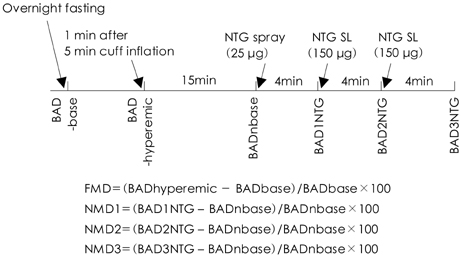Korean Circ J.
2007 Oct;37(10):470-474. 10.4070/kcj.2007.37.10.470.
Hypertension, a Low Ejection Fraction and Severe Angiographic Findings are Associated with Smooth Muscle Dysfunction in Patients with Coronary Atherosclerosis
- Affiliations
-
- 1Division of Cardiology, Konyang University College of Medicine, Konyang University Hospital, Daejeon, Korea. janghobae@yahoo.co.kr
- 2Mayo Clinic, Rochester, Minnesota, USA.
- KMID: 2227047
- DOI: http://doi.org/10.4070/kcj.2007.37.10.470
Abstract
-
BACKGROUND AND OBJECTIVES: Nitroglycerin-mediated arterial dilation (NMD) was shown to be preserved in most previous studies, and this is possibly due to using a single high dose of nitroglycerin (NTG), which causes maximal arterial dilation. We sought to evaluate the clinical factors of flow-mediated dilation (FMD) and NMD at different doses of NTG in the patients with coronary artery disease (CAD).
SUBJECTS AND METHODS
Thirty-two consecutive patients (mean age: 61 years old, 18 males) with angiographically proven CAD underwent FMD and NMD at total cumulative doses of 25microgram, 175microgram and 325microgram with using high-resolution ultrasound for the imaging.
RESULTS
The FMD, NMD (25microgram), NMD (175microgram) and NMD (325microgram) were 4.72+/-1.82%, 7.08+/-3.02%, 13.33+/-6.14% and 15.89+/-7.24%, respectively (p<0.001 compared with each other). Univariate analysis showed that the FMD is associated with the serum homocysteine level, the NMD (25microgram) is associated with the body mass index, the NMD (175microgram) is associated with the fasting blood sugar and the ejection fraction, and the NMD (325microgram) is associated with the fasting blood sugar, while there was no significant difference of the FMD and NMD according to the presence of CAD risk factors. Multivariate analysis disclosed that the independent factors of FMD were the serum homocysteine and triglyceride levels, and those of NMD (25microgram) were hypertension, a low ejection fraction and severe coronary angiographic findings, while there was no independent factor for NMD (175microgram) and NMD (325microgram).
CONCLUSION
This study suggests that hypertension, a low ejection fraction and significant stenotic coronary lesion may be associated with endothelium-independent smooth muscle dysfunction at low dose NTG, while the serum homocysteine and triglyceride levels are associated with endothelium-dependent endothelial dysfunction in the patients with CAD. Using low-dose NTG is important when measuring the NMD.
MeSH Terms
Figure
Reference
-
1. Celermajer DS, Sorensen KE, Gooch VM, et al. Non-invasive detection of endothelial dysfunction in children and adults at risk of atherosclerosis. Lancet. 1992. 340:1111–1115.2. Reddy KG, Nair RN, Sheehan HM, Hodgson JM. Evidence that selective endothelial dysfunction may occur in the absence of angiographic or ultrasound atherosclerosis in patients with risk factors for atherosclerosis. J Am Coll Cardiol. 1994. 23:833–843.3. Fichtlscherer S, Rosenberger G, Walter DH, Breuer S, Dimmeler S, Zeiher AM. Elevated C-reactive protein levels and impaired endothelial vasoreactivity in patients with coronary artery disease. Circulation. 2000. 102:1000–1006.4. Chan SY, Mancini GB, Kuramoto L, Schulzer M, Frohlich J, Ignaszewski A. The prognostic importance of endothelial dysfunction and carotid atheroma burden in patients with coronary artery disease. J Am Coll Cardiol. 2003. 42:1037–1043.5. Adams MR, Robinson J, McCredie R, et al. Smooth muscle dysfunction occurs independently of impaired endothelium-dependent dilation in adults at risk of atherosclerosis. J Am Coll Cardiol. 1998. 32:123–127.6. Raitakari OT, Seale JP, Celermajer DS. Impaired vascular responses to nitroglycerin in subjects with coronary atherosclerosis. Am J Cardiol. 2001. 87:217–219.7. Corretti MC, Anderson TJ, Benjamin EJ, et al. Guidelines for the ultrasound assessment of endothelial-dependent flow-mediated vasodilation of the brachial artery: a report of the International Brachial Artery Reactivity Task Force. J Am Coll Cardiol. 2002. 39:257–265.8. Bae JH, Bassenge E, Kim KB, et al. Postprandial hypertriglyceridemia impairs endothelial function by enhanced oxidant stress. Atherosclerosis. 2001. 155:517–523.9. Suwaidi JA, Hamasaki S, Higano ST, Nishimura RA, Holmes DR Jr, Lerman A. Long-term follow-up of patients with mild coronary artery disease and endothelial dysfunction. Circulation. 2000. 101:948–954.10. Targonski PV, Bonetti PO, Pumper GM, Higano ST, Holmes DR Jr, Lerman A. Coronary endothelial dysfunction is associated with an increased risk of cerebrovascular events. Circulation. 2003. 107:2805–2809.11. Fichtlscherer S, Breuer S, Zeiher AM. Prognostic value of systemic endothelial dysfunction in patients with acute coronary syndromes: further evidence for the existence of the "vulnerable" patient. Circulation. 2004. 110:1926–1932.12. Stuhlinger MC, Oka RK, Graf EE, et al. Endothelial dysfunction induced by hyperhomocyst(e)inemia: role of asymmetric dimethylarginine. Circulation. 2003. 108:933–938.13. Bae JH, Bassenge E, Lee HJ, et al. Impact of postprandial hypertriglyceridemia on vascular responses in patients with coronary artery disease: effects of ACE inhibitors and fibrates. Atherosclerosis. 2001. 158:165–171.14. Bae JH, Kim KB, Kim KS, et al. The effect of vitamin E on the endothelial function following a single high-fat meal in normal subjects, patients with coronary heart disease and patients with diabetes. Korean Circ J. 1998. 28:1538–1551.15. Jarvisalo MJ, Lehtimaki T, Raitakari OT. Determinants of arterial nitrate-mediated dilatation in children: role of oxidized low-density lipoprotein, endothelial function, and carotid intimamedia thickness. Circulation. 2004. 109:2885–2889.16. Gokce N, Holbrook M, Hunter LM, et al. Acute effects of vasoactive drug treatment on brachial artery reactivity. J Am Coll Cardiol. 2002. 40:761–765.
- Full Text Links
- Actions
-
Cited
- CITED
-
- Close
- Share
- Similar articles
-
- The Association between Platelet/Lymphocyte Ratio and Coronary Artery Disease Severity in Asymptomatic Low Ejection Fraction Patients
- Comparison of Coronary Angiographic Findings between Patients with and Those without Stable Angina Pectoris Prior to Acute Myocardial Infarction
- Correlates of the Severity of Coronary Atherosclerosis in Long-term Kidney Transplant Patients
- Activation of Nuclear Factor-kappaB in the Atherosclerotic Human Coronary Artery
- Heart Failure with Preserved Ejection Fraction: the Major Unmet Need in Cardiology



